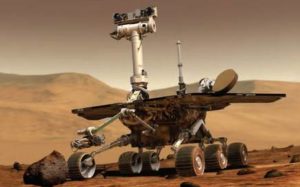NASA’s Dragonfly to look for Origins, Signs of Life in Titan
National Aeronautics and Space Administration (NASA) recently announced its plan to launch Dragonfly drone helicopter to Saturn’s largest moon Titan in search of building blocks of life.
About NASA’s Dragonfly Mission
It is part of space agencies quest to search for building blocks of life and will aim towards collecting samples and examining sites around Saturn’s icy moon, Titan. Dragonfly will launch be launched in 2026 and will arrive at its destination in 2034.
Dragonfly Drone:
The rotorcraft will fly to dozens of promising locations on icy moon Titan looking for prebiotic chemical processes common on both Titan and Earth.
Dragonfly marks the 1st time NASA will fly a multi-rotor vehicle for science on another planet. It will become 1st vehicle ever to fly its entire science payload to new places for repeatable and targeted access to surface materials.
Specifications:
It has 8 rotors and flies like a large drone.
It will take advantage of Titan’s dense atmosphere which is 4 times denser than Earth.
The instruments attached will search for chemical evidence of past or extant life.
Why Titan?
Saturn’s largest moon Titan is the only celestial body besides Earth that is known to have liquid rivers, lakes and seas on its surface, although these contain hydrocarbons like methane and ethane, not water. It is considered to be a richly organic world of its own and is viewed by scientists as an equivalent of very early-era Earth. Thus it can provide clues to how life may have arisen on Earth.
Like Earth’s, Titan’s atmosphere is made mostly of nitrogen (N), but it is 4 times denser.
Titan is 2nd-largest moon in solar system. It has a thick water ice crust, beneath which is an ocean made primarily of water and also its clouds and rains are methane.
Month: Current Affairs - June, 2019


